Earthquake & Tsunami: Andaman and Nicobar
Info: 7321 words (29 pages) Dissertation
Published: 10th Dec 2019
Tagged: Geography
Earthquake & Tsunami (2004 Andaman and Nicobar)
In this documentation there are some basic reason and consequences of catastrophic event that was happened in Andaman and Nicobar Island in India.
The earthquake and tsunami day i.e. Dec.26, 2004
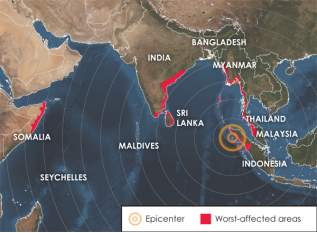 On December twenty six, 2004 at 07:58:53 civil time, a fault rupture was initiated off the geographical region of northern Sumatra, country on the fragment Trench geological process zone plate boundary, triggering a devastating tidal wave around abundant of the Indian Ocean. The geographical point was set at or so 250 metric linear unit sou’-sou’-east of Banda Aceh, the capital town of the Aceh Province in northern Sumatra, Indonesia. From this time, the rupture continued to expand northward for over one, 200 km, generating a colossal M9.3 earthquake, the biggest to own occurred since the 1964 M9.2 AK Earthquake and also the second largest ever recorded. The earthquake rupture was set at a comparatively shallow depth on the geological process zone; estimates of the focal depth vary from ten to thirty metric linear unit. The earth tremor distribution suggests a main fault rupture zone of ninety metric linear unit wide, extending on the one, 200 metric linear unit rupture up to the Andaman Island chain. Total fault movement was around 15m close to Sumatra, with decreasing displacement to the north. During this region, the Indian Ocean plate is moving right down to the east underneath the Union of Burma small plate at a rate of six cm p.a., that the displacement diagrammatic up to 250 years of accumulated plate motion. Many aftershocks were recorded within the following days and months, as well as a second important, M8.7 earthquake on March twenty eight, 2005 at 23:09:36 civil time. This earthquake was set at two.076°N, 97.013°E, southeast of the geographical point of the December 2004 earthquake. This second major shock caused more building injury and triggered another, albeit abundant smaller and localized, tsunami.
On December twenty six, 2004 at 07:58:53 civil time, a fault rupture was initiated off the geographical region of northern Sumatra, country on the fragment Trench geological process zone plate boundary, triggering a devastating tidal wave around abundant of the Indian Ocean. The geographical point was set at or so 250 metric linear unit sou’-sou’-east of Banda Aceh, the capital town of the Aceh Province in northern Sumatra, Indonesia. From this time, the rupture continued to expand northward for over one, 200 km, generating a colossal M9.3 earthquake, the biggest to own occurred since the 1964 M9.2 AK Earthquake and also the second largest ever recorded. The earthquake rupture was set at a comparatively shallow depth on the geological process zone; estimates of the focal depth vary from ten to thirty metric linear unit. The earth tremor distribution suggests a main fault rupture zone of ninety metric linear unit wide, extending on the one, 200 metric linear unit rupture up to the Andaman Island chain. Total fault movement was around 15m close to Sumatra, with decreasing displacement to the north. During this region, the Indian Ocean plate is moving right down to the east underneath the Union of Burma small plate at a rate of six cm p.a., that the displacement diagrammatic up to 250 years of accumulated plate motion. Many aftershocks were recorded within the following days and months, as well as a second important, M8.7 earthquake on March twenty eight, 2005 at 23:09:36 civil time. This earthquake was set at two.076°N, 97.013°E, southeast of the geographical point of the December 2004 earthquake. This second major shock caused more building injury and triggered another, albeit abundant smaller and localized, tsunami.
Map showing the earthquake epicenter, aftershocks, and the extent of the main fault rupture for the M9.3 December 26, 2004 earthquake; the M8.7 March 28, 2005 earthquake, which caused a local tsunami affecting Simeulue Island, Nias Island, and parts of mainland Indonesia is also shown approximately 200 km (124 mi) to the southeast of the December 26, 2004 earthquake.
Ground Shaking
On islands set on the point of the fault rupture, the violent shaking from the 2004 earthquake caused several building collapses. The earthquake additionally angry panic within the Aceh Province of island and also the neighboring province of Sumatera Uttar, as this level of ground shaking had not been tough within the region in recent history. The highest occupied locations to the fault rupture were on the Indian-administered Andaman and Nicobar Islands, wherever several buildings were broken. Within the capital town of Port Blair, roads were cracked and buildings broken. Folks were knocked to the bottom by the severe shaking on automotive Nicobar Island, and a few buildings among the Indian Air Force base were seriously broken. Any abroad, the earthquake was wide felt all round the northern Indian Ocean in Bharat, Sri Lanka, Thailand, Malaysia, Myanmar, and People’s Republic of Bangladesh. Within the state of province in southeast Bharat, folks felt distinct tremors in most components of the port town of city. Across Japanese Bharat, long periods of ground motion caused the water in giant additionally felt in Thailand, as well as in Bangkok. In Malaysia, many high-rise buildings swayed and folks were exhausted in Penang, however no harm was according. In People’s Republic of Bangladesh, the quake was tough within the capital town of capital of Bangladesh also as across the whole country. Storage tanks and ponds to oscillate within the type of searches. In land, a reasonably long tremor was felt on components of the central island. The earthquake tremor was additionally felt in Thailand, as well as in Bangkok. In Malaysia, many high-rise buildings swayed and folks were exhausted in Penang, however no harm was according. In People’s Republic of Bangladesh, the quake was tough within the capital town of capital of Bangladesh also as across the whole country.
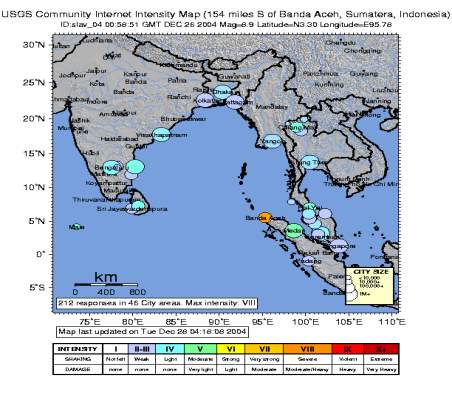
Tsunami
The fast vertical displacement of the ocean floor related to the large fault rupture affected the superjacent water column, initiating a fancy series of waves that propagated across the complete ocean and leading to the devastating tidal wave. As a result of the complete water column is concerned, tsunamis in open oceans have radio radiation lengths of nearly two hundred klick and low trough-to-crest wave amplitudes. The best tidal wave heights square measure propagated laterally removed from fault ruptures, within the direction during which the waves have greatest coherence. During this case, the best waves unfold east-west from the north-south running line. To the north and south on the fault, the waves were subject to interference and reduced in size quickly. To the east and west, the waves solely bit by bit reduced tall as they affected on the far side the ocean to the coast of geographic region. Tidal wave waves travel at a speed proportional to the root of the water depth, reaching 640 km per hour within the deep ocean. Because the waves enter shallower coastal waters, their velocities and wavelengths cut back, and their amplitudes correspondingly increase, resulting in vital and fast inundation of low-lying coastlines. With the time from trough to crest of the waves being usually many minutes, the tidal wave will flow over one klick midland in areas with giant coastal floodplains. The particular height of the tidal wave on a selected section of outline may be a perform of each the peak of the open ocean wave and native factors. The best run-up heights from the 2004 ocean tidal wave were ascertained on the western facet of Banda Aceh furthermore as in alternative cities and cities on the geographic region of Aceh Province. Locally, tidal wave run-up heights reached thirty m during this region, though a lot of typically heights were around 10m. Beyond the earthquake epicenter to the west, in southwest Siam, run-up heights of four to 8m were veteran. To the east in state, run-up heights were between 2.5 and 12m with a mean height of 5. On the southeastern coast of Asian nation, the tidal wave waves reached three.5m on the average. Within the Maldives, the run-up heights were not up to in state, usually reaching a most of 3m, primarily thanks to the absence of a shoaling outline that makes the waves vessel.
Tsunami Casualties:
The list below presents information about on number of known fatalities by country as of 8 January 2005.
Indonesia: At least 94,200 dead and 77,000 missing. The missing figure is almost 10 times higher than the 6,700. The Social Affairs Ministry has put the numbers higher — 101,318 dead; 10,070 missing. There is no explanation for the discrepancy.
Sri Lanka: More than 46,000 dead, with nearly 14,000 missing. Sri Lankan officials say 27,527 are dead and 3,858 missing in non-rebel-held areas of the island nation.
India: 9,691 dead, 6,011 missing — 5,914 on Andaman and Nicobar Islands.
Thailand: 5,187 dead, 3,810 missing.
Somalia: 114, according to the United Nations.
Maldives: 82 dead, 26 missing.
Malaysia: 66 dead, 6 missing.
Myanmar: 86 dead, according to the International Federation for the Red Cross, which is coordinating with the Myanmar government and the United Nations.
Tanzania: 10 dead, according to the U.N.
Bangladesh: 2 dead, according to the U.N.
Kenya: 1 dead, according to Kenyan media.
Seychelles: Unconfirmed reports of deaths.
Historical Perspective:
There is an extended record of tsunamis touching the coastlines of the ocean, primarily on the western coast of island, though there are none in recent history. In 1861, Associate in nursing calculable M8.8-9.2 earthquake burst a lot of the geologic process zone on the West Coast of island, south of the 2004 and 2005 fault ruptures, inflicting injury right along the coast and on the offshore islands of island. Different major tsunami-generating earthquakes had occurred on segments of the geologic process zone in 1797 and in 1833, once large tsunamis flooded the southern a part of western island claiming tens of thousands of lives in every incident. However, over the previous five hundred years, there had ne’er been a serious wave originating from the section of plate boundary that skit in 2004. The biggest previous event on this section was in 1881, once Associate in nursing calculable M8 earthquake within the Andaman Islands caused a modest 1-m wave recorded on tide gauges in Chennai, India. additional back in time, the plate boundary to the north of the 2004 fault rupture skit in a very nice earthquake on the full of the western Abakan coast of Union of Burma in 1762, inflicting important coastal uplift and a moderate wave within the northern ocean. A 2-m rise within the water level was reported close to Dacca, Bangladesh when the event.
However, earthquakes aren’t the sole triggers of tsunamis. A wave generating event befell within the region in 1883, once a destructive discharge suddenly folded the island volcano of volcano situated between island and Java in Indonesia, inflicting the deadliest wave within the region before 2004. Over 36,000 died from the waves that had a most run-up of 40m on the encircling shorelines of the islands. The presence, or absence, of a word for wave within the totally different countries and cultures round the ocean highlights the historical precedent. The word for wave exists in island however is absent in state and Asian country. On the Andaman and Nicobar Islands in island, the autochthone peoples were sufficiently knowledgeable of the hazard following major earthquakes in 1883 and 1941. When experiencing the robust shaking of the earthquake Associate in nursing recognizing the signs of a close wave, they fled to higher ground. In state and Asian country, while not awareness of the signs and consequences of a wave, evacuation was slower and consequently yielded a lot of casualties.
Physical and Human Impacts:
With 174,500 casualties, 51,500 missing, and roughly 1.5 million individuals displaced, the toll of human casualties from the 2004 ocean tidal wave has no trendy historical equal. to know the distribution of the casualties, the tsunami-affected region is divided into 3 areas: the close to field on the coasts of Sumatra, that account for roughly seventieth of the total; those at intermediate distances in Asian nation, India, Sri Lanka, Myanmar, and also the Maldives; and people within the so much field on the coasts of continent and on islands within the western ocean, comparable to the Seychelles Islands. Most of the loss of life occurred within the close to field in Sumatra, Indonesia. The tidal wave destroyed just about each village, town, road, and bridge engineered at below 10m elevation on a 170-km stretch of the western coast of Aceh Province. Whereas inundation failed to extend over one kilometer in most places, the waters reached up to four kilometer landlocked within the flat and densely inhabited town of Banda Aceh. From the reports of fatalities in individual cities on the geographical area of Aceh Province, it’s calculable that on the average five hundredth of the individuals within the coastal region died.
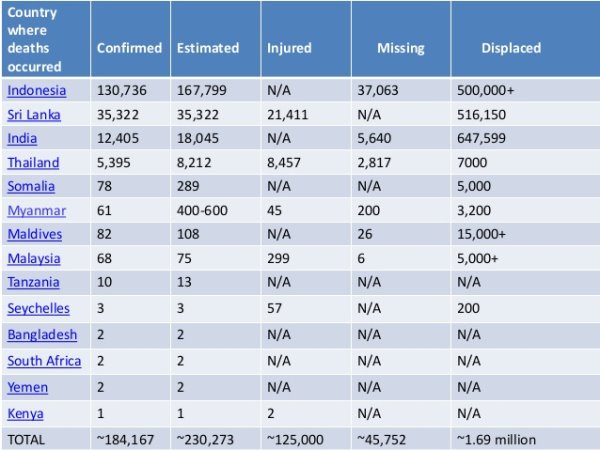
The 31,000 lives lost in state, eightieth were within the most heavily affected areas of the Japanese and southern provinces. The casualty rate among the population living at intervals one kilometer from the coast was between V-day and 2 hundredth. The Japanese aspect of the Northern Province was equally affected. In India, seventy fifth of the ten, 700 fatalities were within the southeastern state of Tamil Nadu. In Thailand, the wave affected residents and foreign tourists within the densely owner-occupied Phuket Island and also the encompassing southern coastal provinces. The deadliness rate among the tourists between seven-membered and ten was doubly the speed of the native residents, as several of the tourists were on the beach or in ground hotels once the wave stricken. There was some loss of life within the areas with two to three m wave waves, and coastlines hit by four to 5-m waves fully fledged five-hitter mortality rates. The most important life loss was seen on coastlines hit by eight to ten m waves, wherever the death rate was around four-hundredth of the population.
Property Damage:
Although the earthquake shaking caused vital building injury within the Aceh Province and on the Andaman and Nicobar Islands in Dutch East Indies, the massive majority of property injury was caused by the wave waves. on coastlines of most of the affected countries, the bulk of the buildings consisted of poorly created homes primarily created out of wood, masonry, and concrete, that build them additional susceptible to injury from a wave. On the southern coasts of state and on the ocean outline of Thailand, tourer resorts and hotels sustained significant injury. Buildings during this equatorial region are settled nearer to water level than is typical of upper latitudes. Thailand and state that are placed during this band don’t oftentimes expertise high winds or maybe severe earthquakes, therefore buildings aren’t generally designed to resist any vital loading. This contrasts with the Jap outline of India, let’s say, wherever comparatively frequent storm surge hazard discourages building at elevations of below two to 3m on top of water level. In general, the native construction quality was no match for the fast flow of water, significantly for structures among the primary 100m, and particularly those lacking protection from different properties or trees. In state, the foremost common housing construction sort is unreinforced masonry that is especially susceptible to collapse from the wave. In one surveyed city in western state, most of the masonry homes among twenty to 30m of the bounds were destroyed. The standard failure mechanism concerned AN out-of-plane collapse of the masonry wall panels caused by the pressure of the advancing surge of water. Several industrial structures and a few additional recently created detached single-family homes are ferroconcrete frames with infill masonry. Whereas the concrete frames usually command in these buildings, the infill panels generally folded, exploit open holes within the structures. In Thailand, typical construction categories embody low and mid-rise ferroconcrete, wood frame, and bamboo buildings. Ancient Thai design uses wood framing and bamboo for construction, leading to a light-weight frame with massive openings. The roofs of those buildings are generally either thatched or covered. On Phuket Island, let’s say, only a few such buildings survived the wave, particularly once the run-up heights exceeded 3m. Within the beach resort areas of Pang Nga Province, timber frame structures close to the shore were destroyed.
Many of the building structures were placed on the beach and took the total forcefulness of the waves. Others were quite 100m interior however still suffered extreme levels of injury thanks to the peak and speed of the waves. Several of the hotels were house vogue, with variety of single-story wood and bamboo structures scattered over the property. These resorts suffered the foremost injury, particularly wherever the wave heights exceeded eight m. different hotels on Phuket Island are mid-rise ferroconcrete of superior construction standards. These buildings generally have shear walls within the thwart wise direction, larger columns, and different walls fashioned by cast-in-place unreinforced masonry panels. A number of these structures performed remarkably well, even in locations wherever the wave reached or maybe exceeded the upper floors of the buildings. All told of the affected regions, there was massive loss of tiny water craft, as well as native fishing boats, yachts, and even tiny load ships in numerous ports across the ocean. Particularly, the port of city on the geographical area of India sustained moderate injury. The native fishing fleet was affected, with variety of boats turned or washed on land among the harbor.
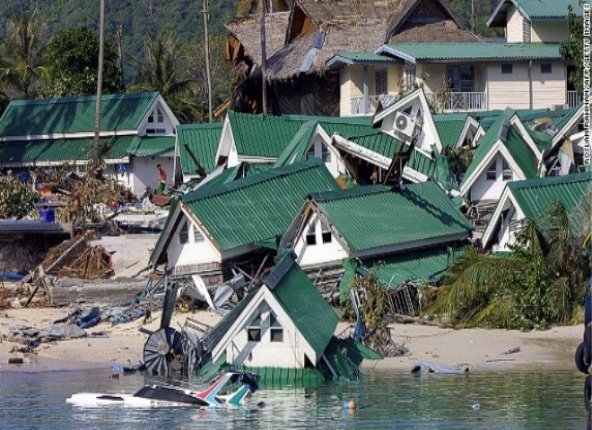
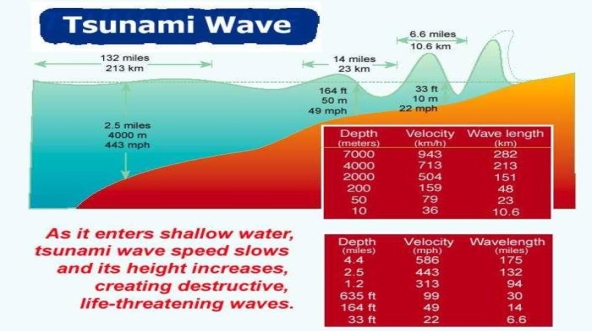
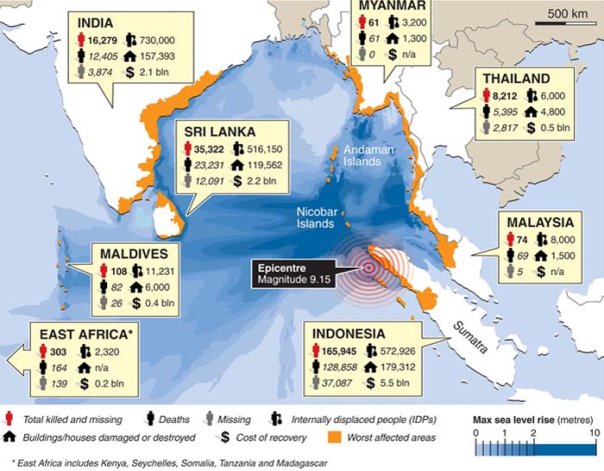
Economic and Insured Losses
Overall economic losses from the 2004 Indian Ocean Earthquake and wave disaster area unit calculable at $10 billion, with seventy fifth of the loss attributed to the injury within the Republic of Indonesia, Thailand, Sri Lanka, and India. These losses embody injury to residential and industrial buildings and infrastructure, as well as roads, facility systems, power systems, schools, hospitals, and alternative health care facilities. although the big majority of the injury was on the geographic region of island, Indonesia, and to a lesser extent the countries of Republic of India and Ceylon, the economy of the Maldives, that lies solely a number of meters higher than water level, was most heavily compact. Losses within the Maldives diagrammatical close to forty fifth of its gross domestic product (GDP).While Republic of Indonesia suffered $4.5 billion in economic loss, representing the complete GDP of the Aceh Province, the loss resulted during a bottom impact on the general Indonesian economy, lowering the projected growth by close to 0.2% in 2005.
Insured Property Loss:
In the worst affected countries of Indonesia, India, and country, the insurance penetration to hide flood or earthquake connected perils was very low. Any abroad, the key insured exposure concentrations in Kuala Lumpur, Asian country and Singapore were unaffected by the earthquake and wave, though building occupants in these cities felt the bottom shaking. In Indonesia, basic residential earthquake coverage includes wave harm, and extended coverage for wave harm is out there for industrial and industrial risks with a typical fireplace policy. However, non-life penetration in Indonesia could be a fraction of the penetration rates seen within the U.S., New Sjaelland, and Japan. Amount of money for tsunamis varies by country and line of business. Typically wave coverage is AN extension to a typical fireplace policy and/or a separate endorsement to earthquake or flood coverage. In some cases, it’s lined beneath AN all-risks contract. In the U.S., residential wave coverage is purchased with flood coverage through the National Flood Insurance Program (NFIP). In New Sjaelland, residential wave harm is roofed beneath the earth science disaster insurance purchased through the Earthquake Commission. In Japan, coverage for a flood or wave ensuing from AN earthquake may be other to an advertisement earthquake insurance that is AN extended coverage to the quality fireplace policy. Residential coverage for earthquake shock and fireplace, discharge, and wave following earthquake could be a separate policy purchased in conjunction with a basic house policy.
COUNTRY ECONOMIC LOSSES ($ MILLION) INSURED LOSSES ($MILLION)
INDONESIA 4500 500
THAILAND 1,000 500
SRILANKA 1,000 100
INDIA 1,000 100
MALDEVES 500 50
OTHERS 2000 50
TOTAL 10,000 1300
At most, twelve-tone music of the $4.5 billion in Indonesian economic losses were insured. Similar insured loss patterns were old in Republic of India, wherever the loss or harm to property is roofed below a regular hearth and special perils policy for residential and industrial risks. In Sri Lanka, under two hundredth of the affected population had property insurance, and thus few of the 93,000 destroyed homes resulted during a claim. In Thailand, however, property coverage additional ordinarily involves all-risks policies that embrace a provision for earthquake-related harm. This sort of coverage, combined with a comparatively high insurance penetration compared to the opposite countries within the affected region, resulted during a higher proportional insured loss during this country. The bulk of the 50,000 policies within the six most seriously affected Thai provinces were lined. Among per week of the disaster, over five hundred claims amounting to almost $25 million had already been filed. Among all the buildings broken and destroyed across the Indian Ocean, solely little proportion of the upper worth bounds industrial or building facilities were insured. These embrace little variety of factories in Sumatra, further as hotels in Sri Lanka, the Maldives, and Thailand. Of all the affected areas, the wealthiest was the tourer economy on the Thai coast, wherever hotels further as higher worth homes and stores had insurance. The RMS estimate for the full price of all properties claims is around $1.3 billion. Whereas this total springs from many lines, together with many massive industrial risks in Indonesia and port facilities in Republic of India, the massive portion of the insured loss is primarily because of harm to tourer resorts and business interruption instead of industrial or producing installations. In Jan 2005, the business enterprise Authority of Thailand according that almost two hundredth of Phuket Island’s building capability was discontinuous by the wave. One year following the event, whereas nearly all of the broken hotels on Phuket Island have reopened, Phuket was still troubled to revive the regional business enterprise trade.
Life, Health, and Travel Insurance Costs:
The total life and private accident insurance claims from native populations were little because of low penetration of insurance in Asian country, Sri Lanka, and Republic of Indonesia. whereas up to common fraction of the population in Asian country had life and private accident insurance, most of these affected were lower financial gain residents WHO had restricted or no coverage through a private accident policy. Similarly, whereas over ten of Indonesians have insurance, few of the 30,000 residents living within the ravaged town of Banda Aceh close to the geographical point of the earthquake control insurance policies. Insurance claims for health, life, and travel cowl were nearly entirely from foreign tourists tormented by the event in Kingdom of Thailand, Sri Lanka, and therefore the Maldives. They were paid go in several separate countries in step with the quantity of these affected. Around 2,200 foreign tourists died or area unit probable dead from the tidal wave. The very best numbers of casualties were from Sverige and Germany– every country with quite five hundred confirmed dead. Alternative countries with quite a hundred casualties embody Suisse, Finland, and therefore the UK. On average, half-hour of European travelers leisure overseas have travel insurance. Several travel insurance policies embody restricted protect accidental death however a lot of intensive protect medical treatment and homecoming. Injuries area unit consequently a lot of pricey to travel insurers. Therefore, the injuries sustained by foreign tourists created up a major portion of the travel insurance loss. Supported info accessible within the months following the disaster, the whole life, health, and travel insurance claims were not up to $300 million. Combining the property loss with the potential life, health, and travel insurance prices, the whole insurance loss from this event is around $1.6 billion. If the event were to require place in another a part of the globe and below completely different market conditions, the insured loss might are far more important. Disasters like this highlight the importance of managing exposure accumulations and suitably rating disaster risk, because the 2001 World Trade Center attacks conjointly illustrated.
Accumulation Zones:
Tsunami hazard sources in and round the sea offer sensible samples of however coastal property exposure will accumulate across country boundaries and insurance markets. The 1755 European nation national capital port, Earthquake that ravaged the Algarve region of Portugal generated a serious tidal wave, with wave heights reminiscent of those of the 2004 Indian Ocean tidal wave. Waves reached thirty m in cards, Portugal, fifteen m on southwest European nation, and in more than five on southwest Espino and also the Atlantic Coast of Morocco. Like the 2004 Indian Ocean tidal wave, the tidal wave waves were powerfully polarized within the way field. Thus, whereas the tidal wave waves weren’t detected within the ports on the geographic region of North America, within the Indies run-up heights reached to five m on variety of islands as well as island, Dominica, Saba, and St. Martin.
At the Jap aspect of the sea, the 365 C.E. earthquakes situated on the Hellenic Arc geological process zone is that the greatest famed historical earthquake within the region, inflicting many meters of uplift in western Kriti. The earthquake created a devastating tidal wave that wedged the southern coast of Kriti and also the northern coast of Egypt, notably in Alexandria. The tidal wave waves additionally traveled east towards Cyprus, west towards Malta, Sicily, and Libya and north towards the Hellene and Adriatic Seas. On condition that it had not been recognized that the oblique geological process zone north of island may generate a M9.0 earthquake, a review of different sections of geological process zones may yield unrecognized mega tidal wave sources. The foremost notable facet regarding the two hundred4 Indian Ocean Earthquake was that the section of the plate boundary that damaged had not toughened an excellent earthquake for a minimum of the previous 200 years. To boot, the Philippine Sea geological process zone that runs from southern island Island, Japan to Taiwan has not had any major rupture for the past 2 centuries and has been highlighted as a possible analog to the Sundar trench north of island. A tidal wave generated from this supply would have an effect on the Pacific lineation of southwest China around Shanghai, a part acquainted with the impacts of storm storm surges and thus less in danger than the coasts of southwest Asian country and land. A second geological process zone ‘gap’ is found at the Caribe’s geological process zone on the Jap fringe of the Caribbean. Excluding its northern finish, that stony-broke in 1843, this space additionally has not had any major plate boundary earthquakes within the past five hundred years. A mega-tsunami triggered from this supply would powerfully have an effect on the Caribe’s Islands, as well as the western coast of Barbados, furthermore as probably propagating across the Caribbean to Central America. Different tsunamis that might have an effect on many sections of lineation from identical original cause embracer are however extreme events generated by underwater volcanic collapses or landslides. Lateral collapses of oceanic island volcanoes manufacture the most important landslides toughened up to now. Though no such lateral collapse is understood within the chronicle, residual detritus found on the seafloor support their prevalence in recent time, particularly round the most apace growing volcanoes like within the archipelago. Geologically young and very massive landslide deposits are mapped altogether of the island, wherever a minimum of a dozen major flank collapses have occurred within the past many million years. earth science proof suggests that in some future eruption, the limit Viejas Volcano on the island of Los Angeles Palma within the Canary Island chain of the jap Atlantic Ocean might expertise a ruinous failure of its western flank, dropping one hundred fifty to five hundred km3 of rock into the ocean. The question on however tsunami-generating such a collapse would be is far debated. Within the most pessimistic and apocalyptic interpretation, the entire flank enters the ocean as one block moving at speeds bigger than one hundred per second. But most geologists take into account that the collapse would be advanced, and blocks would fragment and disintegrate, as seems to own been the case in past episodes of flank collapse. During this case, there would be multiple moderately-sized tsunamis. In nearly any state of affairs, the island would be badly affected, however a serious tidal wave with run-up of ten m on the U.S. geographic region needs circumstances that a lot of geologists take into account implausible.
Managing Tsunami Risk:
The 2004 ocean wave highlighted inherent vulnerabilities of the world’s coastlines and therefore the people that live there. Coastal population’s area unit on the rise in several components of the planet, largely because of the exploitation of ocean resources or tourism-related activities. Adequate mitigation measures from wave hazard are often place in situ to save lots of lives, property, and therefore the livelihoods of these living on the coast. a good vary of approaches are often used for mitigation, as well as wave warning systems, education, code standards, land use coming up with, and alternative engineering solutions.
Education and Warnings:
Education is one among the best ways in which to scale back tidal wave life loss. Such education has to embody data of the reason for a tidal wave and its association with the biggest earthquakes facilitate to assist people perceive however their own observations will help them take applicable action. Most tidal wave hazard is targeted on coastlines sufficiently near to the earthquake fault rupture, therefore the vibrations are going to be powerfully felt. The length of ground shaking may be smart indicator of Associate in Nursing at hand tidal wave: something lasting a moment or a lot of may be a sign of an excellent earthquake with the potential to cause a grave tsunami.
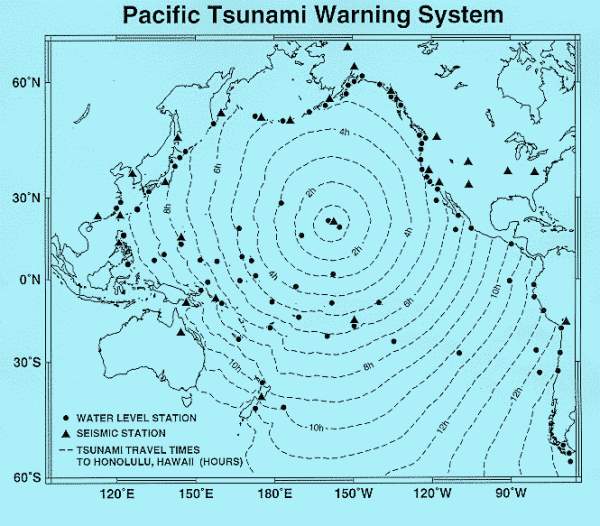
However, the earthquake might not be felt at a distance from the supply, and thus it should be the movements of the ocean that may offer the simplest indicator that a wave is getting ready to arrive. In several (but not all) tsunamis, the primary movement of the ocean may be a withdrawal. Any occasion once the ocean level recedes apace and inexplicably ought to be taken as an indication for immediate flight to higher ground. There are, sadly, several stories of individuals following the receding water to gather stranded shellfish solely to be swamped by the following wave. Pictures from the 2004 event can go an extended means in serving to educate several coastal dwellers regarding the warning signs. Additionally, the primary wave isn’t essentially the foremost devastating one. The 1960 M9.5 Chile Earthquake generated a wave that traveled across the Pacific. The primary wave that hit the city of Hilo, Hawaii was only one.2 m, whereas the waves that followed measured up to five.5 m tall. As warning systems that track the passage of the wave within the open ocean square measure being developed, self-facilitate solutions may be supplemented with data on a way to answer official warnings, akin to those delivered through radio, telephone messages, or sirens. However, official warning systems will offer solely a part of the answer as data will ne’er be effectively disseminated to everybody on outline. With solely ten to half-hour warning within the close to field of major tsunamis, it’s imperative that individuals square measure schooled to require their own action instead of look forward to official instruction. The state of Hawaii has endeavored to coach its population regarding the danger of way field tsunamis traveling across the Pacific. Hawaii governmental agencies post maps of wave risk zones and evacuation routes in hotels and on beaches. Additionally, the Pacific wave Warning Center surpass National Oceanic region Administration (NOAA) has been provision wave warnings since 1948. When the 1960 Chile Earthquake, it issued a warning for Hawaii that saved several lives in Hilo as folks exhausted to higher ground. However, in step with a U.S. earth science Survey report following the event, whereas the majority in Hilo detected the warning sirens, solely a little understood them as an indication to evacuate. Wave response drills square measure currently performed often in Hawaii to coach folks a way to respond. Following the 2004 wave, the International Oceanographic Commission (IOC) of the U.N. instructional, scientific associate degreed Cultural Organization (UNESCO) committed to developing an ocean wave early warning system. Separately, Siam launched a National Disaster Warning Center in might 2005, changing into the primary country hit by the 2004 ocean wave to launch associate degree early warning system.
Physical Mitigation Measures:
Japan and also the Hawaiian Islands represent the territories and coastlines most often littered with damaging tsunamis. Since 684 C.E., Japan has had seventy three tsunamis that caused over 100,000 deaths. The overwhelming majority of those tsunamis were generated from close to field earthquakes on the plate boundaries that pass near to the coasts of Japan. As a result, Japan could be a leader in wave mitigation, with efforts directed each toward the fast supply of wave warnings also on physical mitigation measures in high wave risk areas. once a wave elicited by the 1933 Showa-Sanriku Earthquake seriously broken the Sanriku Pacific coastal space, some communities were settled to higher locations, seawalls were created on the coast, wave warning systems were established, and evacuation routes were selected. In some fishing villages, wave gates are erected at the entrances to bays and harbors to guard against flooding. A lot of recently, Japan has established stricter building codes to guard buildings from each earthquakes and tsunamis. Similarly, in Hawaii, building laws designate the categories of structures and occupancies allowed in zones deemed in danger from wave inundation. In distinction to natural barriers to AN approaching wave or storm wave love coastal forests, seawalls are built structures that offer protection from approaching waters. Whereas an efficient tool for wave mitigation, seawalls are a bulkier and costlier means that of providing protection as compared to different land use measures. However, the city of Yoshihima, Japan was protected by its 6-m high breakwater throughout the 1960 Chile Earthquake and wave. A lot of recently, Male, the capital town of the Maldives, was protected within the 2004 Indian Ocean wave by its three.5-m breakwater. While not this concrete breakwater, the wave would doubtless have destroyed 1/2 town. In India, tsunami-hit arras in state are presently constructing seawalls to guard the outline. For coastlines wherever tsunamis are rare, sure building zone rules and construction standards are often enforced. Maybe, if a building love a port warehouse should be placed close to the ocean, it are often created specified the bearing walls are perpendicular to the bound. During this method, the wave impacts the non-bearing or partition walls, and also the building doesn’t collapse. Additionally, roads designed perpendicular to the outline, instead of parallel thereto, will offer wave evacuation routes. wherever coastal floodplains are thus in depth that it’s unattainable to evacuate to higher ground midland, the challenge for structural engineers is to develop Schematic diagram of a T-type flood wall that may be designed to face up to inundation waves from a wave (Image: U.S. Army Corps of Engineers) Stem Water facet Heel Toe piling Cutoff (Optional) Base breadth Ground Line Land facet cost-efficient construction strategies that guarantee survival of all people who have taken refuge on the building’s higher floors. Maybe, for a wave with run-up of six m or less, such buildings will offer vertical evacuation routes to guard folks against storm surge floods, as they need drained Bangla Dash.
Modeling Tsunami Risk:
For any lineation, wave hazard reflects the vary of attainable heights and come periods of expected tsunamis. The run-up height versus come amount curve reflects a compound of all the potential sizes and distance ranges of wave generating events. Tsunamis can exhibit native variations tall in step with the form of the seafloor that is simply inevitable wherever elaborated hydraulic modeling has been undertaken. For locations within the close to field of geologic process zones, hazard are driven by the expected size and come periods of major earthquakes on the plate boundary. As shown by the 2005 M8.7 earthquake, wave heights will be terribly sensitive to earthquake size. This earthquake solely generated a wave with a pair of to 3m run-up heights, in distinction to the 30m run-up heights practiced in Banda Aceh following the 2004 M9.3 event. To calculate wave risk at a location, it’s necessary to know however way the wave wave can propagate interior, still because the elevations of buildings and their vulnerability to the force of the water. Like all flooding, risk can rely upon the elevation and explicit state of affairs. Even for the very best hazard locations, damaging tsunamis don’t occur additional usually than once each one hundred years, therefore the wave risk can invariably be not up to 1 Chronicles and usually not up to zero.1% of the property price. However, for a few low-lying locations on coasts with considerable wave hazard, tsunamis will be a principal driver of risk, significantly for properties deliberately engineered on the brink of water level, comparable to land hotels and port facilities. Like all flood modeling, high resolution data is required to differentiate risk. On the far side risk rating, the 2004 ocean Earthquake and wave have additionally highlighted problems with risk accumulation that head to the guts of insurance portfolio management. Vital earthquake harm affected the 2 territories of Sumatra and therefore the Indian Nicobar and Andaman Islands, whereas 5 countries sustained major wave harm and localized impacts affected another ten countries. It’s vital to contemplate however wave risk and wave accumulations ought to be taken under consideration wherever catastrophe risks square measure already shapely for those perils and locations. Initial it should be recognized that the regional extent of the 2004 wave was terribly uncommon. Most wave risk is focused within the close to field of major geologic process zone earthquake sources. An honest example will be found on the geographical region coast from Crescent town, California up to southern island, Washington. An oversized Cascadian geologic process zone earthquake, with the potential to rupture all or a majority of this plate boundary, would trigger a wave that may possible inundate low-lying communities on the neighboring sea-coast, as happened in 1700. as luck would have it, such a wave would be considerably attenuated by the time it more established the inlets of the Puget Sound in Washington, though it may still cause potential losses to port and ferry facilities within the neck of the woods.
Tsunami losses would solely comprise a minor element of the overall losses, though they figure within the overall magnitude of prices to be expected from such a catastrophe. However, wave risk could be a major element of the danger within the exposed Pacific coastal communities, wherever surely properties it’s possible to exceed earthquake risk. In terms of different extreme accumulations of wave risk, the main target for insurers and reinsurers ought to air testing accumulations on mixtures of coastlines with the potential to be wedged by constant event.
The 2004 ocean wave encompasses a come amount longer than five hundred years, and there’s no prospect of another event of comparable size being generated on this explicit section of the plate boundary. However, its impacts will serve to alert the planet to wave hazard and mitigation wants. So as to scale back the vulnerability of people and property on exposed coastlines round the world, protecting measures square measure necessary. A wave warning system is especially guaranteed within the ocean and may be integrated with different risk assessment and mitigation methods as well as education, hazard mapping, coastal measuring investigations, and land use designing.
Cite This Work
To export a reference to this article please select a referencing stye below:
Related Services
View allRelated Content
All TagsContent relating to: "Geography"
Geography is a field of study that is focused on exploring different places and environments from around the world. Different aspects of Geography include countries, habitats, distribution of populations, the Earth's atmosphere, the environment, and more.
Related Articles
DMCA / Removal Request
If you are the original writer of this dissertation and no longer wish to have your work published on the UKDiss.com website then please:




